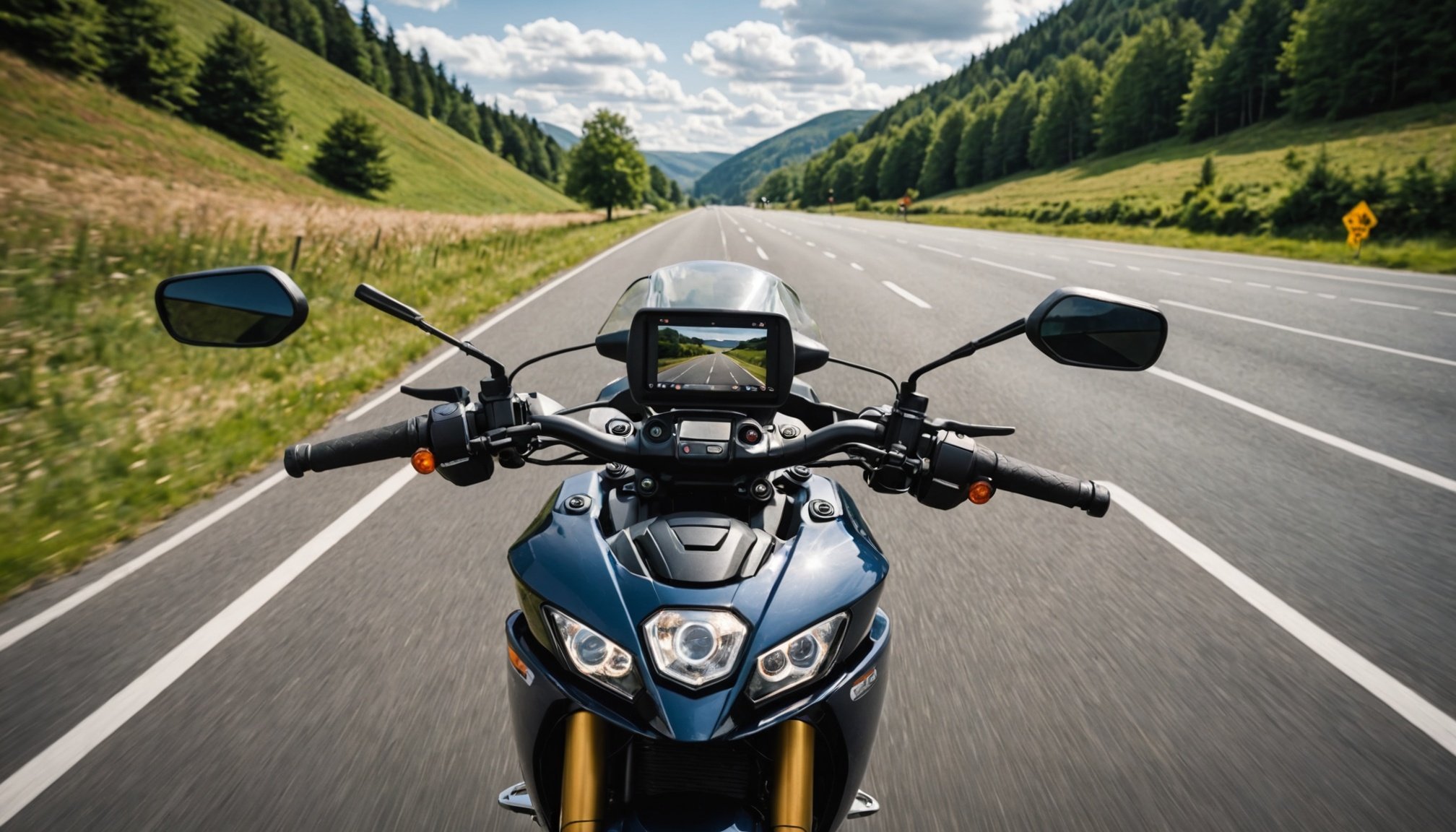Introduction to Dash Cameras for Sport Bikes
Dash cameras have become a valuable asset for sport bike riders, offering several advantages. Firstly, they provide an invaluable tool for recording rides, which can help in case of accidents or disputes on the road. The footage serves as evidence, potentially aiding insurance claims or legal proceedings. Furthermore, dash cameras enhance security by deterring theft and vandalism, acting as a silent witness while your bike is parked.
However, it’s crucial to consider the legal landscape in the UK when using a dash camera on a sport bike. Riders must comply with privacy laws, ensuring that their footage does not infringe on the privacy rights of others. Understanding these regulations helps riders avoid legal complications and maintain compliance.
Also to read : Ultimate guide to effortlessly install a hydraulic clutch on your sports bike for smooth riding in uk traffic
When selecting a dash camera for a sport bike, several features should be carefully considered. High-definition video quality is essential to capture clear and detailed footage. Additionally, features like wide-angle lenses, waterproofing, and night vision capabilities ensure optimal performance in various conditions. Battery life and storage capacity also play a significant role in determining the camera’s overall effectiveness.
By choosing the right dash camera and adhering to UK regulations, sport bike riders can enjoy increased safety and peace of mind during their journeys.
Have you seen this : Ultimate guide to effortlessly install a hydraulic clutch on your sports bike for smooth riding in uk traffic
Legal Considerations for Dash Cameras in the UK
Navigating UK road laws concerning dash cameras requires a thorough understanding of the regulations to ensure legal compliance. Generally, dash cameras are legal on UK roads, but drivers must adhere to specific guidelines. Primarily, cameras must not obstruct the driver’s view. This is crucial to remain within legal standards and avoid penalties.
In terms of personal data protection, the UK follows similar guidelines to the GDPR, mandating that individuals obtain consent if their dashboard camera records identifiable people outside their vehicle. Proper signage and informing passengers about the camera use can help maintain compliance.
Dash cameras can be pivotal in insurance disputes and legal proceedings. When an accident occurs, high-quality footage can provide unbiased evidence. This footage assists in establishing fault, often expediting insurance claims processing. However, it’s essential that footage is not manipulated, as altered evidence can be inadmissible in court.
Overall, while dash cameras can significantly enhance security and accountability, owners must be diligent about adhering to privacy laws and road regulations to use them effectively and legally.
Step-by-Step Installation Guide for Dash Cameras
Installing a dash camera on your sport bike requires precision but can be achieved with a few tools and careful preparation. First, gather essential tools and materials: a small screwdriver set, adhesive mounts, zip ties, a power connection cable, and your selected dash camera. It’s crucial to select a mounting technique that ensures stability while riding at high speeds.
Installation Process
-
Choose the Mounting Position: Opt for spots on your sport bike that avoid obstructed views like the front windshield or handlebars, ensuring the lens captures the road accurately.
-
Secure the Mount: Clean the desired area thoroughly to ensure the adhesive sticks well. Attach the adhesive mount or bracket, depending on your camera type, using either screws or the provided adhesive pads.
-
Connect the Power: Run the power connection cable discretely along the bike’s frame, avoiding the engine and moving parts. Use zip ties to keep cables secure and prevent tangling or damage.
-
Test the Setup: Before heading out, ensure the dash camera is functioning correctly and recording the desired field of view. Test the camera in various lighting conditions to check for clarity.
Be vigilant to avoid common pitfalls such as loose wiring that can interfere with bike functionality or obscure the lens by improper positioning.
Recommendations for Dash Camera Models for Sport Bikes
Selecting the best dash cameras for sport bikes requires consideration of essential specifications that cater to safety and quality. When choosing a model, focus on camera specifications like field of view, resolution, and frame rate. These features ensure that the camera captures every detail clearly as you ride. Additionally, consider models with GPS capabilities and built-in stabilization, crucial for maintaining steady footage on bumpy roads.
Some top-recommended dash camera models for sport bikes include the Garmin 66W and the Thinkware Sports M1. The Garmin 66W boasts a wide 180-degree field of view and 1440p resolution, ensuring high-quality video. Thinkware’s Sports M1 offers full HD dual-channel recording and electronic image stabilization, making it another solid choice.
When thinking about cost considerations, it’s vital to balance price with value for money. While high-end models like INNOVV K5 come with steep price tags due to their advanced features, more budget-friendly options exist that still provide excellent functionality. Prioritizing the right specifications within your budget can boost your riding experience while ensuring safety and enjoyment.
Optimal Positioning and Mounting Tips
Establishing the perfect camera positioning for dash cams on sport bikes is crucial. Begin by considering the dash cam mounting location; it should provide a full view without obstructing the rider’s view. Ideally, place the camera closer to the center for balanced visibility and to capture footage directly in front.
Effective visibility and angles significantly enhance recording quality. Aim the camera slightly upwards to encompass both the road ahead and surrounding vehicles. Adjustments should be done carefully to maintain focus on key areas while still highlighting the immediate surroundings for comprehensive coverage.
When positioning your dash cam, consider how wind and vibration may affect it. Sport bikes, with their aerodynamic builds and high speeds, can create noticeable wind resistance. Use sturdy mounts to reduce vibrations that might blur the footage. Securing your camera mount with anti-slip pads can also help stabilize the view by minimizing these disturbances.
By following these mounting tips, you’ll ensure your dash cam records clear and useful footage. This will aid during incidents and can be crucial evidence should any disputes arise during your rides. Such planning assures the best protection and utility from your dash cam setup.
Best Practices for Video Storage and Management
Efficient video storage and dash cam footage management hinges on selecting the right storage medium and understanding the nuances of data retention. To ensure optimal performance, consider high-quality SD cards with substantial storage capacity and high endurance, which are pivotal for withstanding continuous writing cycles and various environmental conditions.
Effectively managing your footage begins with establishing a routine for backing up dash cam footage. Utilize external hard drives, cloud storage, or network-attached storage (NAS) systems to maintain duplicates of crucial videos. This redundancy safeguards against data loss due to device failure or accidental deletion.
When contemplating data retention, align your practices with local legal guidelines. Many regions require footage retention for a specific period, especially if the footage could be integral to legal proceedings. Create a systematic approach to review and erase unnecessary clips, freeing up storage while maintaining compliance with legal standards. Consider automated solutions or software that can schedule regular deletions or prompts for manual reviews.
By implementing these strategies, you’ll be equipped to manage your dash cam footage securely and efficiently. This proactive approach not only protects your data but also ensures you’re always prepared, whatever your needs might be.
Understanding Usage Rights and Privacy Concerns
When it comes to dash cam footage, comprehending data usage rights is crucial. Generally, the owner of the dash cam holds the rights to the recorded material. However, local laws can affect how and when you can utilize these recordings. Primarily, footage may be used legally for personal use, such as evidence in case of an accident or legal conflict. Any commercial use, sharing on social platforms, or distribution demands explicit consent from all parties involved, reflecting the inherent need to respect privacy and individual rights.
Understanding privacy concerns associated with dash cam footage is equally significant. It’s vital to ensure that any recordings made don’t inadvertently infringe on people’s privacy, especially in locations where privacy expectations are assumed, like residential areas. It’s advised to inform passengers or individuals in proximity that a recording device is in operation.
To safeguard privacy and ensure legal use of dash cam footage, it’s essential to:
- Familiarize yourself with the specific laws in your region.
- Avoid recording sensitive or private spaces where privacy is expected.
- Seek appropriate permissions if the footage is intended for external sharing or commercial use.
Respecting these guidelines ensures ethical use of dash cam technology while protecting individual privacy.
Implications of Non-Compliance
Understanding the implications of non-compliance is crucial for anyone involved in industries with strict regulations. Failure to adhere to guidelines can lead to significant legal ramifications. One of the most immediate non-compliance risks is the potential for hefty fines and penalties imposed by regulatory bodies. For instance, improper usage of equipment or neglecting safety protocols can result in financial penalties, affecting a company’s bottom line.
Besides fines, insurance consequences are also a critical concern. Non-compliance can impact insurance claims and coverage, potentially voiding policies or leading to higher premiums. Insurers may refuse to cover incidents arising from negligence, leaving companies financially vulnerable after unforeseen events.
Past legal cases underscore the importance of compliance. Companies lacking compliance measures have faced lawsuits, resulting in legal fees and reputational damage. Compliance serves as both a preventative measure and a strategic approach to ensure smooth operations and secure long-term success. It is not merely about avoiding punishments but also safeguarding against non-compliance risks that could jeopardise business continuity. Therefore, prioritising compliance is not only a legal obligation but also a prudent business strategy.











